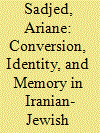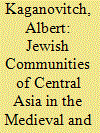| Srl | Item |
| 1 |
ID:
179849


|
|
|
|
|
| Summary/Abstract |
The paper discusses the narratives of Jews from Mashhad, who were forced to convert to Islam in 1839. The community narrative as well as academic research is dominated by a modern understanding of religious identity and religious boundaries that fail to account for the diversity of practices among the community of converts, including multiple forms of religious belonging, and the switching of identities according to time and place. Based on historical sources and interviews with descendants from the Mashhadi community, the paper traces how a particular narrative of the history of the Jews from Mashhad prevailed and which significance this narrative entails for Mashhadi community and identity until today. While the Jews from Mashhad are a rather unique case among Iranian Jews–due to the long period in which they lived as converts–their pattern of memory building reflects a general trend among Jews from the Muslim world to assimilate to modern ideas of being Jewish.
|
|
|
|
|
|
|
|
|
|
|
|
|
|
|
|
| 2 |
ID:
168992


|
|
|
|
|
| Summary/Abstract |
When the Jews first settled in Central Asia is uncertain, but circumstantial evidence clearly indicates that this happened at least two and a half thousand years ago. In the first millennium AD, the Jews lived only in cities no farther than 750 km east of the Caspian sea (in the eighth–eleventh centuries the sea was called Khazarian). Only later did they migrate to the central part of the region, to cities like Samarkand and Bukhara. It is possible that Jews from Khazaria joined them, since they already had tight trade connections with Central Asia and China. There is no trace of evidence regarding the existence of Jews in the entirety of Central Asia in the early sixteenth century. At the very end of the sixteenth century Bukhara became the new ethnoreligious center of the Jews in that region. In the first half of the nineteenth century, thanks to European travelers visiting Central Asia at that time, the term “Bukharan Jews” was assigned to this sub-ethnic Jewish group. Drawing on a wide range of primary and secondary source materials, this article aims to prove that the presence of Jews in Central Asia was not continuous, and therefore the modern Bukharan Jews are not descendants of the first Jewish settlers there. It also attempts to determine where Central Asia’s first Jewish population disappeared to.
|
|
|
|
|
|
|
|
|
|
|
|
|
|
|
|